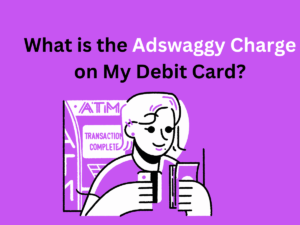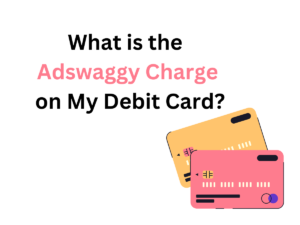In today’s digital age, where online transactions have become the norm, it’s not uncommon to spot unfamiliar charges on your bank or credit card statements. One such charge that has left many consumers puzzled is the “Adswaggy” charge. If you’ve recently noticed this entry on your debit card statement and are wondering what it is, you’re not alone.
This article aims to shed light on what the Adswaggy charge is, why it might appear on your debit card, and what steps you can take if you believe it to be unauthorized or fraudulent.


Understanding the Adswaggy Charge
The term “Adswaggy” is not widely recognized as a mainstream company or service, which is why it often raises concerns when it appears on a debit card statement. Based on available information, Adswaggy appears to be associated with online advertising, digital marketing services, or subscription-based platforms. It is possible that Adswaggy is a third-party service provider that charges users for access to certain features, content, or tools. Users may want to consider contacting their bank or financial institution if they see an unexpected charge. Additionally, businesses involved in fdy advertising services in kyiv might also be connected to this term, as they often utilize various platforms to promote their offerings. It is advisable for consumers to research any unfamiliar charges to avoid potential scams or unauthorized transactions. In many cases, charges like these are linked to free trials or subscriptions that users sign up for online. For example, you might have signed up for a free trial of a service that required you to input your debit card information. If you didn’t cancel the trial before it ended, the service may have automatically converted into a paid subscription, resulting in the Adswaggy charge on your statement.
How Did the Adswaggy Charge End Up on My Debit Card?
There are several ways the Adswaggy charge could have appeared on your debit card statement. Below are some of the most common scenarios: Free Trial Conversion Many online platforms offer free trials to attract users. These trials often require you to provide your debit card information upfront. If you forget to cancel the trial before it ends, the service may automatically charge you for a subscription. Adswaggy could be one such service that operates on this model. Unintentional Sign-Up Sometimes, users unknowingly sign up for services while navigating websites or clicking on ads. This can happen if the sign-up process is not clearly explained or if the website uses deceptive practices to collect payment information. Third-Party Charges Adswaggy might be a third-party service associated with another platform you use. For instance, if you signed up for a webinar, online course, or app, Adswaggy could be the payment processor or service provider handling the transaction. Fraudulent Activity Unfortunately, not all charges on your debit card are legitimate. If you don’t recognize the Adswaggy charge and haven’t signed up for any related services, it could be a case of fraud or unauthorized use of your card.Steps to Identify the Source of the Charge?
Before taking any action, it’s important to determine whether the Adswaggy charge is legitimate or unauthorized. Here’s how you can investigate: Review Your Recent Transactions Go through your recent online activities and transactions. Try to recall if you signed up for any free trials, subscriptions, or services that might be linked to Adswaggy. Check Your Email Search your email inbox for keywords like “Adswaggy,” “subscription,” “free trial,” or “payment confirmation.” Many services send a confirmation email when you sign up or are charged. Visit the Website If you suspect the charge is related to a specific service, visit the website and look for terms of service, billing information, or contact details. Some websites list their payment processor or billing name, which might match the Adswaggy charge. Contact Your Bank If you’re unable to identify the source of the charge, contact your bank or card issuer. They can provide additional details about the transaction and help you determine whether it’s legitimate.What to Do If the Charge Is Unauthorized?
If you’ve determined that the Adswaggy charge is unauthorized or fraudulent, it’s important to act quickly to protect your finances. Here’s what you can do: Dispute the Charge Contact your bank or card issuer and inform them that you did not authorize the Adswaggy charge. Most banks have a dispute resolution process that allows you to challenge unauthorized transactions. Be prepared to provide details about the charge and any evidence you have. Cancel Your Card If you suspect that your debit card information has been compromised, request a new card from your bank. This will prevent further unauthorized charges. Monitor Your Account Keep a close eye on your bank statements and transaction history for any additional suspicious activity. Report any unfamiliar charges to your bank immediately. Report Fraud If you believe you’ve been a victim of fraud, consider filing a report with your local authorities or a consumer protection agency. This can help prevent others from falling victim to the same scam.How to Avoid Unwanted Charges in the Future?
To prevent similar charges from appearing on your debit card in the future, follow these tips: Read the Fine Print Before signing up for any free trial or subscription, read the terms and conditions carefully. Pay attention to the billing details, cancellation policy, and any recurring charges. Use Virtual Cards Some banks offer virtual debit cards that can be used for online transactions. These cards have limited funds or can be deactivated after a single use, reducing the risk of unauthorized charges. Set Up Alerts Enable transaction alerts on your debit card. This way, you’ll be notified immediately of any charges, allowing you to spot and address unauthorized transactions quickly. Keep Track of Subscriptions Maintain a list of all your active subscriptions and their renewal dates. Set reminders to cancel any services you no longer wish to use. Be Cautious Online Avoid clicking on suspicious ads or pop-ups, and only provide your payment information on trusted websites.
Is Adswaggy a Scam?
The legitimacy of Adswaggy depends on the context in which the charge appears. If you knowingly signed up for a service associated with Adswaggy, the charge is likely legitimate. However, if you have no recollection of signing up for anything related to Adswaggy, it could be a scam. Scammers often use vague or unfamiliar names on billing statements to make it harder for consumers to identify and dispute charges. If you suspect that Adswaggy is a scam, report it to your bank and relevant authorities.What Do Adswaggy Charges and MBI SETL Charges Have in Common on My Bank Statement?
Both Adswaggy charges and MBI SETL charges can appear on bank statements, potentially causing confusion for consumers. Understanding mbi setl charge details is essential to differentiate these charges, as they may relate to different services or transactions. Clarity on these entries helps maintain better financial tracking and budgeting.
